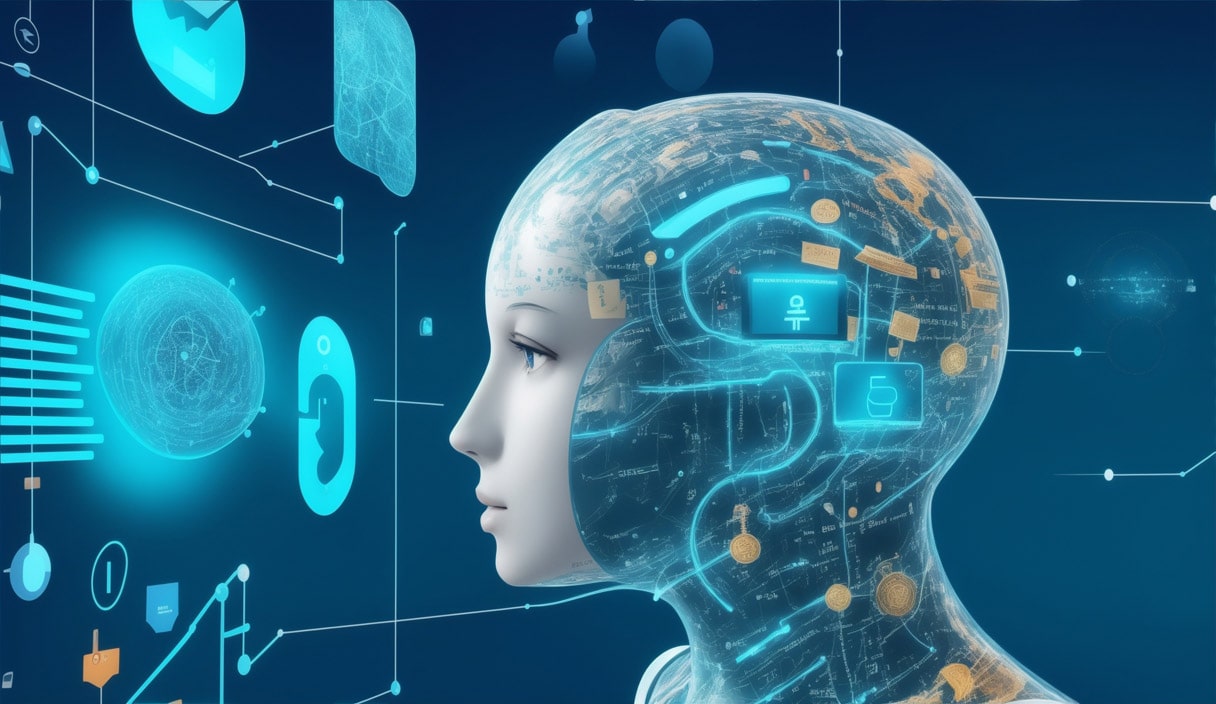Artificial Intelligence (AI) and Big Data are two significant forces transforming myriad industries across the globe, and marketing is no exception.
Artificial Intelligence, often simply referred to as AI, involves machines that can mimic intelligent human behaviour. In the marketing sphere, this involves machine learning algorithms capable of learning from and interpreting complex data to make autonomous decisions and predictions.
Big Data, on the other hand, represents vast and complex data sets, which are characteristically large in volume, variety, and velocity. It’s the sheer scale and detail of this data that offers profound insights and business intelligence that were previously unattainable with conventional data analysis tools.
The marketing landscape of the 21st century is, without a doubt, digitally driven. The explosion of digital channels has led to an unprecedented volume of data generated every second, from consumer behaviours to transactional data. As such, the ability to harvest, decipher, and use this information to formulate effective marketing strategies is a crucial determinant of a business’s success.
AI and Big Data are revolutionising the way marketers approach, engage, and serve customers. The adoption of AI technologies provides marketers with the tools to turn data into actionable insights, while Big Data offers the raw information necessary for understanding markets on a granular level. Together, they empower businesses to personalise customer experiences, optimise marketing campaigns, predict trends, and ultimately achieve a superior competitive edge.
In the following sections, we’ll delve into the specifics of how AI and Big Data are reshaping modern marketing strategies, including the challenges they present and how marketers can prepare for this paradigm shift.
The Evolution of Modern Marketing
Marketing has come a long way since its inception. The journey started from the simple trade era, where the focus was merely on product distribution due to the limited variety of goods. This was followed by the sales era, where increased competition necessitated persuasive sales techniques to unload inventories.
The marketing department era ensued, marking the introduction of a more customer-focused approach with companies striving to understand customer needs to offer better solutions. The marketing company era further shifted power to consumers, driving businesses to develop cohesive marketing strategies across all areas of operation.
The advent of the digital age signalled a new era in marketing – the customer-centric era. The rise of the internet and later, social media platforms, transformed the way businesses communicated with their customers. Information became readily available, and customers became more informed, discerning, and demanding. The explosion of digital channels enabled companies to reach a global audience with precision and speed like never before.
Digital technology also facilitated the collection and storage of vast amounts of data, a valuable asset in understanding and anticipating customer behaviour. Customers’ digital footprints, whether it be their search queries, online purchases, or social media interactions, became an abundant source of insights, marking the transition into data-driven marketing.
Data-driven marketing, as the name implies, refers to the strategy of utilising customer information and data analytics to optimise marketing strategies and enhance business performance. It has become an integral component of modern marketing due to the digital age’s data-rich environment.
The introduction of advanced analytics tools and AI has further amplified this trend. Businesses are now not just reactive but proactive, using predictive analytics to anticipate customer behaviour and trends. With the integration of AI and Big Data, marketers can draw on vast amounts of data in real-time, extracting relevant insights and delivering personalised experiences at an unprecedented scale.
These technological advancements have created a marketing landscape that is more dynamic, precise, and customer-centric than ever before. Yet, they also bring new challenges and complexities that businesses need to navigate, a subject we will delve into in the forthcoming sections.
Understanding AI and Big Data
Artificial Intelligence (AI) is a branch of computer science concerned with building smart machines capable of performing tasks that would typically require human intelligence. These tasks include learning from experiences, understanding language, recognising patterns, solving problems, and making decisions. The field of AI is broad and includes several subsets such as machine learning, deep learning, natural language processing, and computer vision.
Big Data, on the other hand, refers to extremely large and complex data sets that are challenging to manage, process, and analyse using traditional database and software technologies. These data sets can be structured (like data in databases), unstructured (like text or images), or semi-structured (like XML files). The four V’s—Volume, Velocity, Variety, and Veracity—characterise Big Data. Volume refers to the amount of data, Velocity to the speed of data generation, Variety to the different types of data, and Veracity to the reliability of data.
AI and Big Data are two powerful technological phenomena that have found a synergistic relationship in the digital age. AI thrives on large amounts of quality data to learn, adapt, and improve. Conversely, the effective utilisation of Big Data necessitates AI to make sense of the vast, complex, and rapidly expanding data landscapes.
When combined, they have the potential to transform industries and redefine competitive landscapes. For marketers, this union offers the ability to understand and predict consumer behaviour on an individual level, personalise customer experiences, optimise marketing strategies in real-time, and make more informed strategic decisions.
Key components and terms to understand
- Machine Learning (ML): This is a subset of AI that involves the development of algorithms that allow computers to learn from and make decisions or predictions based on data. The more data fed into the machine learning algorithm, the better it becomes at predicting outcomes.
- Predictive Analysis: This technique uses statistical algorithms and machine learning to predict future outcomes based on historical data. It’s a key component of data-driven marketing, allowing businesses to anticipate customer behaviour and trends.
- Deep Learning: This is a more advanced form of machine learning that mimics the functioning of the human brain in processing data for use in decision making. Deep learning can be particularly effective in recognising patterns in unstructured data, like images or natural language.
- Natural Language Processing (NLP): This is an AI function that enables machines to understand and interact in human language, allowing more seamless interactions with AI-powered chatbots and voice assistants.
- Data Mining: This process involves examining large databases to generate new information. It allows marketers to discover patterns in large data sets involving methods at the intersection of machine learning, statistics, and database systems.
Understanding these key terms and components will facilitate a better understanding of how AI and Big Data influence modern marketing strategies, which we will delve into in the next section.
The Impact of AI and Big Data on Marketing Strategies
In an era where consumers crave unique, relevant experiences, personalisation is key. AI and Big Data enable marketers to deliver highly personalised messages and experiences to their customers. By analysing a wide range of data points such as consumer browsing habits, purchasing behaviour, and social media interactions, AI can identify individual preferences and deliver content, recommendations, or offers that cater specifically to the individual’s needs and interests.
Predictive marketing takes personalisation a step further by using data to forecast future consumer behaviour. By identifying patterns in historical and real-time data, AI algorithms can predict what a customer is likely to do next, allowing marketers to anticipate needs and influence decisions proactively.
Customer segmentation involves grouping customers based on shared characteristics to enable targeted marketing. Big Data provides a wealth of information about customers, and AI can analyse this data to create more precise and meaningful segments. This can include not just demographic data, but also psychographic and behavioural data, leading to a more nuanced understanding of different customer groups.
AI and Big Data can streamline and enhance various aspects of marketing. AI algorithms can automate repetitive tasks, freeing up marketers to focus on more strategic work. Furthermore, AI can optimise marketing campaigns in real-time, adjusting bidding strategies, targeting parameters, or content based on performance data. By providing valuable insights, Big Data helps marketers make informed decisions that lead to better marketing outcomes.
AI and Big Data can drastically enhance the customer experience. From AI chatbots providing instant customer service to predictive analytics improving product recommendations, these technologies make interactions smoother, more relevant, and more satisfying for customers.
Case Studies Showcasing Successful Implementation
- Netflix: The streaming giant uses AI and Big Data to personalise content recommendations for each user, leading to increased viewer engagement and retention.
- Amazon: The e-commerce platform utilises AI and predictive analytics to recommend products, optimise pricing, and even anticipate purchases, contributing to its reputation for seamless, customer-centric service.
- Starbucks: The coffee chain uses Big Data to understand customer preferences, optimise store locations, and personalise marketing messages, enhancing customer loyalty and boosting sales.
These case studies provide tangible evidence of the potential of AI and Big Data in marketing. However, despite their immense promise, these technologies also present certain challenges, as we will discuss in the next section.
Risks and Challenges in Implementing AI and Big Data
The usage of AI and Big Data in marketing inherently involves the collection and analysis of large volumes of customer data, which raises significant privacy concerns. As a result, businesses need to be aware of privacy regulations like the General Data Protection Regulation (GDPR) in the EU and the Data Protection Act in the UK. Non-compliance can result in hefty fines and serious reputational damage.
AI systems are only as good as the data they are trained on. If the training data contains biases, the AI system can inadvertently perpetuate or even amplify these biases, leading to unfair or discriminatory outcomes. Furthermore, the use of personal data for profiling and targeting can raise ethical questions about manipulation and consent. Businesses need to take steps to identify and mitigate biases in their AI systems and approach the use of personal data with transparency and respect for customers’ rights.
Implementing AI and Big Data in marketing is not a simple task. It requires integrating new technologies with existing systems, which can be complex and time-consuming. Furthermore, interpreting and acting on Big Data and AI outputs require a certain level of expertise. Businesses may need to invest in training or hiring skilled personnel to fully leverage these technologies.
While AI and Big Data can provide powerful insights, they should not replace human judgment. Data can show what is happening and predict what might happen in the future, but it cannot explain why. Understanding the why often requires human intuition, experience, and a deep understanding of the business context. Over-reliance on AI and data can lead to decisions that are technically correct but contextually inappropriate or strategically misguided.
In the next section, we will explore steps marketers can take to prepare for and navigate these challenges as they embrace the use of AI and Big Data in their marketing strategies.
Preparing for the AI and Big Data Revolution: Steps for Marketers
Before embarking on the AI and Big Data journey, marketers should assess their organisation’s readiness. This includes understanding the company’s current data capabilities, identifying gaps in technology, skills, and processes, and securing executive buy-in for the necessary investments and changes. The assessment should also consider the organisation’s risk tolerance, as AI and Big Data initiatives can involve significant costs, risks, and uncertainties.
Implementing AI and Big Data requires a robust technology infrastructure capable of handling large volumes of data and performing complex computations. This includes hardware (like servers and storage) and software (like databases, data processing, and AI tools).
Equally important is building the necessary skills. This can involve training existing staff, recruiting new talent, or a combination of both. Key skills include data analytics, machine learning, programming, and data privacy.
Given the complexity and rapid pace of change in AI and Big Data technologies, it can be beneficial to partner with technology providers or consultants. They can provide the necessary expertise, technology solutions, and guidance to accelerate the implementation process and improve the chances of success.
A clear, step-by-step implementation plan can guide the AI and Big Data journey. The plan should define clear goals, key performance indicators (KPIs), timelines, responsibilities, and contingencies. It should start with small, manageable projects to generate quick wins and learnings before moving on to larger, more complex initiatives.
Finally, marketers should aim to future-proof their marketing strategies. This means continuously monitoring trends and developments in AI and Big Data, adopting a culture of continuous learning and innovation, and being prepared to adapt and evolve as the technology advances and customer expectations change. It also means maintaining a balanced perspective that values and integrates data-driven insights with human intuition and creativity.
By following these steps, marketers can prepare their organisations for the AI and Big Data revolution and harness these technologies’ potential to transform their marketing strategies and business performance.
The Future of AI and Big Data in Marketing
Hyper-personalisation: As AI and Big Data technologies mature, the level of personalisation in marketing is expected to increase dramatically. Consumers will receive marketing messages tailored not just to their preferences, but also to their real-time context and mood.
Real-time Marketing Optimisation: AI will enable marketers to optimise campaigns in real-time, adjusting targeting, content, and bidding strategies based on up-to-the-minute performance data.
Predictive Customer Journey Mapping: AI and Big Data will facilitate the creation of predictive customer journey maps, enabling marketers to anticipate customer needs and behaviours at each stage of the customer journey.
AI-Driven Content Creation: AI will play a larger role in content creation, generating copy or visual content based on data insights and testing different versions to optimise performance.
The Role of Emerging Technologies
Quantum Computing: With its potential to process massive amounts of data exponentially faster than traditional computers, quantum computing could significantly enhance AI capabilities and speed up the processing and analysis of Big Data.
Blockchain: Blockchain could play a role in ensuring data privacy and transparency, with potential applications in customer data management and digital advertising.
The Evolving Role of the Marketer in the AI Era
The rise of AI and Big Data does not spell the end of the marketer, but rather the evolution of the role. Marketers will need to develop new skills in data analytics, machine learning, and AI. They will also need to become comfortable working with AI tools and interpreting their outputs.
However, the importance of traditional marketing skills, such as creativity, strategic thinking, and customer understanding, will not diminish. Instead, the marketer of the future will be a hybrid, blending technical and data skills with traditional marketing capabilities.
In conclusion, AI and Big Data are powerful forces shaping the future of marketing. By understanding these technologies and preparing for their implications, marketers can harness their potential to create more effective marketing strategies, deliver superior customer experiences, and drive business success in the digital age.
Recap and Final Thoughts
This article examined the transformative influence of AI and Big Data on modern marketing strategies. We began by providing a detailed understanding of AI and Big Data, highlighting their synergistic relationship and key components. We then explored how these technologies are enhancing personalisation, customer segmentation, marketing efficiency, and customer experience, with case studies from Netflix, Amazon, and Starbucks showcasing their successful implementation.
Despite the many benefits, we also discussed the challenges, including data privacy concerns, ethical implications, the complexity of integration, and the danger of over-reliance on AI and data-driven decision-making. As a response, we presented steps for marketers to prepare for the AI and Big Data revolution, from assessing organisational readiness and building necessary infrastructure and skills, to crafting an implementation plan and future-proofing marketing strategies.
Finally, we looked into the future, discussing predictions for the next decade, the role of emerging technologies like quantum computing and blockchain, and the evolving role of the marketer in the AI era.
In a rapidly changing digital landscape, the integration of AI and Big Data into marketing strategies is no longer a luxury but a necessity for businesses seeking to stay competitive. These technologies hold immense potential for transforming marketing practices, delivering value to customers, and driving business success.
However, harnessing this potential requires more than just technical investment. It calls for a shift in mindset, a willingness to innovate, and a commitment to blending the new with the traditional. It’s about seeing AI and Big Data not as replacements for human marketers, but as tools that can augment human capabilities and free marketers to do what they do best – creating, connecting, and inspiring.
Embracing AI and Big Data is, therefore, more than just a tactical move. It’s a strategic choice that can define a business’s future in the digital age. As we move forward, it will be those businesses that understand this and act on it that will thrive, setting new standards for customer experience and defining the future of marketing.






